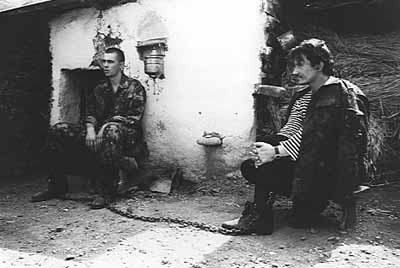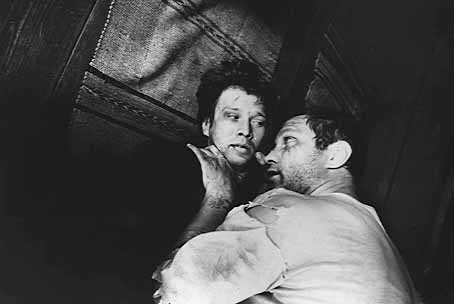|
The series purported to present the best, rather than the typical. At least two of the movies--The Moslem and Peculiarities of National Hunt--were nominated for this year's Nikes, the Russian answer to the Oscars. (From the way things work in Russia, I would not be surprised if the athletic-shoe company were indeed one of the sponsors.) If you add a few more pictures from the festival circuit, like The Prisoner of the Caucasus--soon to come out in the US--the forest behind the trees begins to take shape.
When asked about the biggest problem faced by the Russian film industry, most filmmakers--as well as Galina Verevkina, the Russian coordinator of the MOMA show--will say one word: Money. In the old days, this was not an issue: as long as the proposed script was politically (well, ideologically) correct, the Party's checkbook opened wide. In the imperial ideology, Big was Good; Huge was even Better. Thus Sergei Bondarchuk, the Cecil B. De Mille of Soviet movies, could commandeer Army divisions to stage Napoleonic battles for his ten-hour-long War and Peace (recently shown on PBS in its entire jaw-breaking boredom); or Yuri Ozerov could do the same for the WWII in his Liberation of Europe epic. (It seems that, between WWII and the Afghanistan invasion, moviemaking represented the most strenuous form of exercise for the Soviet Army.)
Responding to glasnost, Soviet filmmakers hastily shook dust off the scripts long hidden in their desks and stormed the studios' suddenly amenable Creative Councils. It was in the late '80s that films like Victor Pichul's Little Vera and Sergei Soloviev's Assa broke through, exposing Russian life as it was: in the former, vodka-sodden citizens went for one another's throats at the slightest provocation; in the latter, the hypocrisy of the older generation resisted the change demanded by young hipsters. Other directors rushed to attack the dogmas of recent history; according to one filmmaker I talked to, at least six films were made that featured scenes depicting Stalin's funeral.
And then the Party fell, and its equivalent of the studio system fell along with it. When I visited Mosfilm a few years ago, a walk through its dimly lit catacomb-like corridors, with crumbling walls and rotting odors, was not for the faint-hearted. Nowadays, things are reportedly worse. Right: there is no money. The entire Russian industry is an exaltation of independent producers, who often form companies on the project-by-project basis. According to Ms.Verevkina, the state, represented by Roskino, still can foot up to 80% of the bill; but no producer can do without venture capital from banks or trading companies. If the filmmaker has some international cachet, like Nikita Mikhalkov (Burnt by the Sun) or Pavel Lungin (Taxi Blues), a French or a German company will step in to help. While an average Russian film's budget is still not on Hollywood scale, ranging anywhere from $1 to $10 million, it's quite a chunk of money for a country where $300 a month incomes are the rule. No wonder that last year only 24 films were made. This does not cover vanity productions that serve to launder money and typically showcase brand-new millionaires' girlfriends; these seldom get wide distribution. (Now that's a setup I'd dearly love to see on film, with a Russian Steve Buscemi surrounded by Mafiosi in gaudy track suits).
At least Russia has not produced its own Michael Ovitzes, so the budgets are not burdened by the stars' salaries. Although, whipped up by lavish media coverage, screen-idol worship flourishes; not even a fine actress like Inna Churikova (seen here in Adam's Rib) or Oleg Menshikov (the Chekist in Burnt by the Sun) can guarantee box office. And what is box office, anyway? Three years ago, theaters were dominated by the unbeatable combination of Arnold, Jean-Claude, and assorted Hong Kong high kickers. Now the distribution is in a state of decay, the theater owners (read: their former managers) have rented space to Jeep dealerships; video market is barely opening, and foreign sales are the real make-or-break factor. Yet another irony Russia abounds in: an American-owned lushly appointed theater named Kodak has opened in Moscow, complete with Dolby system and buttered popcorn. Why not? The Nikes nominations were announced at the Moscow branch of Planet Hollywood. (Wha? Yep. They got that, too. Next year, Dunkin' Donuts, an establishment eagerly awaited by Moscow's finest.)
|





